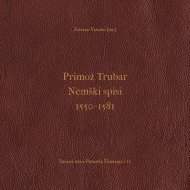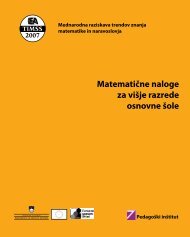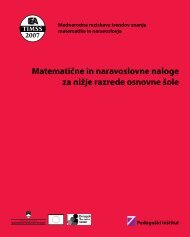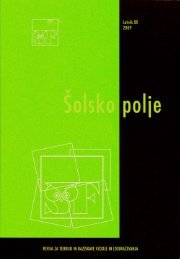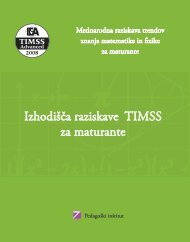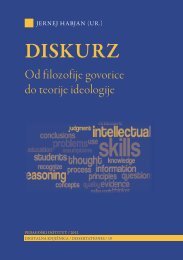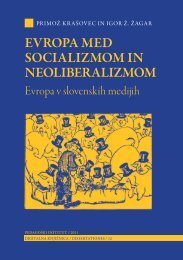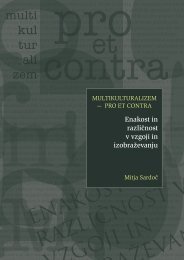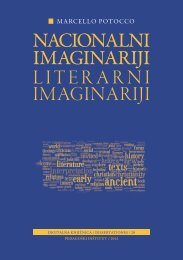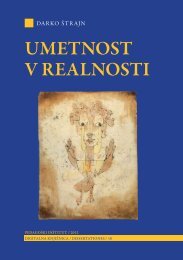72 ŠOLSKO POLJE LETNIK <strong>XX</strong> ŠTEVILKA 5/6Notes[1] All emphases (bold) in the article are mine (IŽŽ).[2] The paper was recently published in Critical Discourse Studies 6/4 (<strong>2009</strong>),under the title »Recontextualising fascist ideologies of the past: rightwingdiscourses on employment and nativism in Austria and the UnitedKingdom«. In this article, I will be referring to the manuscript version.[3] There are many more, I’ve just limited my analysis to the most recent ones.[4] Let alone the fact that there is no (theoretical) explanation why there shouldbe list(s) at all.[5] Members of the European Parliament (IŽŽ).[6] It is worth noting that each topos can (usually) have two »converse« forms.Therefore the phrasing of this topos could also read: »If a specific actioncosts too much money, this action should be stopped«, depending on thecontext, and/or on what we want to prove or disprove.[7] An important and more than credible exception in this respect is SaraRubinelli with her excellent and most thorough monograph on Topoi, ArsTopica, The Classical Technique of Constructing Arguments from Aristotle toCicero, Argumentation Library, Springer, <strong>2009</strong>.[8] This table is an extrapolated and reworked version of the topoi listed inAristotle’s Rhetoric B 23. It was taken from an excellent website on rhetoric,Silva Rhetoricae (http://humanities.byu.edu/rhetoric/Silva.htm).[9] See Rubinelli, <strong>2009</strong>: 8-14.[10] The 29 topoi in the Rhetoric cannot all be found among the 300 topoi fromthe Topics. There is a long-standing and heated debate about where these29 topoi come from, and how the list was composed. Rubinelli (<strong>2009</strong>:71-73) suggests that their more or less »universal applicability« may be thecriterion.[11] Which is probably due to the fact that Cicero was selecting and using loci inconjunction with the so-called stasis theory (or issue theory). What is stasistheory? Briefly (and simplified), the orator has to decide what is at stake(why he has to talk and what he has to talk about): 1) whether somethinghappened (or not); 2) what is it that happened; 3) what is the nature/qualityof what happened; 4) what is the appropriate place/authority to discusswhat has happened. And Cicero’s loci »followed« this repartition.[12] It should be emphasized, of course, that DHA is not an argumentationtheory per se, it is just using argumentation (or some parts of it).[13] Our sample analysis is, of course, purely hypothetical.
TOPOI IN CRITICAL DISCOURSE ANALYSIS73References:Aristotle. (1989). Topica (Transl. by E. S. Forster). Cambridge, Massachusetts: HarvardUniversity Press.Aristotle, (1991). Art of Rhetoric (Transl. by J.H. Freese). Cambridge, Massachusetts:Harvard University Press.Cicero, M. T. (2003). Topica (Transl. by T. Reinhardt). Oxford: Oxford UniversityPress.Curtius, R. E. (1990). European Literature and the Latin Middle Ages. New Jersey:Princeton University Press.Fairclough, N. (1995). Critical discourse analysis: the critical study of language.Harlow: Longman.Fairclough, N. (2000). Discourse and Social Change. Cambridge: Polity Press.Fairclough, N. (2003). Analysing Discourse: Textual Analysis for Social Research.London/New York: Routledge.Galasinska, A. and Krzyzanowski, M. (eds.). (<strong>2009</strong>). Discourse and Transformation inCentral and Eastern Europe. Basingstoke: Palgrave Macmillan.Kienpointner, M. (1992). Alltagslogik. Stuttgart-Bad Cannstatt: Frommann-Holzboog.Perelman, Ch. and Olbrechts-Tyteca, L. (1983). Traité de l'argumentation. La nouvellerhétorique. Bruxelles: Editions de l'Université de Bruxelles.Reisigl, M. and Wodak, R. (2001). Discourse and Discrimination. Rhetoric of Racismand Antisemitism. London/New York: Routledge.Richardson, J. E. (2004). (Mis)Representing Islam: the racism and rhetoric of BritishBroadsheet newspapers. Amsterdam: John Benjamins.Richardson, J. E. and Wodak, R. (2008). The impact of visual racism: Visual argumentsin political leaflets of Austrian and British far-right parties. (Manuscript. Paperpresented at the 2008 Venice Argumentation Conference).Rubinelli, S. (<strong>2009</strong>). Ars Topica. The Classical Technique of Constructing Argumentsfrom Aristotle to Cicero. Berlin: Springer.Toulmin, S. (1995). The Uses of Argument. Cambridge: Cambridge University Press.van Leeuwen, Th. (2004). Introducing Social Semiotics. London/New York:Routledge.van Leeuwen, Th. (2008). Discourse and Practice. New Tools for Critical DiscourseAnalysis. Cambridge: Cambridge University Press.van Leuween, Th. and Kress, G. (2006). Reading Images: The Grammar of VisualDesign. London/New York: Routledge.Wodak, R. (<strong>2009</strong>). The Discourse of Politics in Action. Basingstoke: PalgraveMacmillan.Wodak, R. and Chilton, P. (eds.). (2005). A New Agenda in (Critical) DiscourseAnalysis. Amsterdam/Philadelphia: John Benjamins.Wodak, R. and Meyer, M. (eds.). (2006). Methods of Critical Discourse Analysis.London: Sage.Wodak, R. and van Dijk, T. (eds.). (2000). Racism at the Top. Klagenfurt: Drava.Wodak, R., de Cillia, R., Reisigl, M. and Liebhart, K. (1999). The Discursive Constructionof National Identity. Edinburgh: Edinburgh University Press.
- Page 3:
VSEBINA LETNIK XX ŠTEVILKA 5/6 Z
- Page 7 and 8:
UVODNA NOTICAIgor Ž. ŽagarTole pi
- Page 9 and 10:
ZA KAJ GRE V KAD - PREGLEDZGODOVINE
- Page 11 and 12:
ZA KAJ GRE V KAD - PREGLED ZGODOVIN
- Page 13:
ZA KAJ GRE V KAD - PREGLED ZGODOVIN
- Page 17 and 18:
ZA KAJ GRE V KAD - PREGLED ZGODOVIN
- Page 19 and 20:
ZA KAJ GRE V KAD - PREGLED ZGODOVIN
- Page 21 and 22:
ZA KAJ GRE V KAD - PREGLED ZGODOVIN
- Page 23 and 24: ZA KAJ GRE V KAD - PREGLED ZGODOVIN
- Page 25 and 26: ZA KAJ GRE V KAD - PREGLED ZGODOVIN
- Page 27 and 28: DISKURZ: FOUCAULT, LACLAU TERZAPOPA
- Page 29 and 30: DISKURZ: FOUCAULT, LACLAU TER ZAPOP
- Page 31 and 32: DISKURZ: FOUCAULT, LACLAU TER ZAPOP
- Page 33 and 34: DISKURZ: FOUCAULT, LACLAU TER ZAPOP
- Page 35 and 36: DISKURZ: FOUCAULT, LACLAU TER ZAPOP
- Page 37 and 38: DISKURZ: FOUCAULT, LACLAU TER ZAPOP
- Page 39 and 40: DISKURZ: FOUCAULT, LACLAU TER ZAPOP
- Page 41 and 42: DISKURZ: FOUCAULT, LACLAU TER ZAPOP
- Page 43 and 44: DISKURZ: FOUCAULT, LACLAU TER ZAPOP
- Page 45 and 46: DISKURZ: FOUCAULT, LACLAU TER ZAPOP
- Page 47 and 48: DISKURZ: FOUCAULT, LACLAU TER ZAPOP
- Page 49 and 50: TOPOI IN CRITICAL DISCOURSE ANALYSI
- Page 51 and 52: TOPOI IN CRITICAL DISCOURSE ANALYSI
- Page 53 and 54: TOPOI IN CRITICAL DISCOURSE ANALYSI
- Page 55 and 56: TOPOI IN CRITICAL DISCOURSE ANALYSI
- Page 57 and 58: TOPOI IN CRITICAL DISCOURSE ANALYSI
- Page 59 and 60: TOPOI IN CRITICAL DISCOURSE ANALYSI
- Page 61 and 62: TOPOI IN CRITICAL DISCOURSE ANALYSI
- Page 63 and 64: TOPOI IN CRITICAL DISCOURSE ANALYSI
- Page 65 and 66: TOPOI IN CRITICAL DISCOURSE ANALYSI
- Page 67 and 68: TOPOI IN CRITICAL DISCOURSE ANALYSI
- Page 69 and 70: TOPOI IN CRITICAL DISCOURSE ANALYSI
- Page 71 and 72: TOPOI IN CRITICAL DISCOURSE ANALYSI
- Page 73: TOPOI IN CRITICAL DISCOURSE ANALYSI
- Page 77 and 78: University of Queensland, Centre fo
- Page 79 and 80: JOURNALISTIC (RE)PRODUCTION OF HIST
- Page 81 and 82: JOURNALISTIC (RE)PRODUCTION OF HIST
- Page 83 and 84: JOURNALISTIC (RE)PRODUCTION OF HIST
- Page 85 and 86: JOURNALISTIC (RE)PRODUCTION OF HIST
- Page 87 and 88: JOURNALISTIC (RE)PRODUCTION OF HIST
- Page 89 and 90: JOURNALISTIC (RE)PRODUCTION OF HIST
- Page 91 and 92: JOURNALISTIC (RE)PRODUCTION OF HIST
- Page 93 and 94: JOURNALISTIC (RE)PRODUCTION OF HIST
- Page 95 and 96: JOURNALISTIC (RE)PRODUCTION OF HIST
- Page 97 and 98: JOURNALISTIC (RE)PRODUCTION OF HIST
- Page 99 and 100: JOURNALISTIC (RE)PRODUCTION OF HIST
- Page 101 and 102: JOURNALISTIC (RE)PRODUCTION OF HIST
- Page 103 and 104: THE VOICE OF AN AGENDA-SETTINGAUTHO
- Page 105 and 106: THE VOICE OF AN AGENDA-SETTING AUTH
- Page 107 and 108: THE VOICE OF AN AGENDA-SETTING AUTH
- Page 109 and 110: THE VOICE OF AN AGENDA-SETTING AUTH
- Page 111 and 112: THE VOICE OF AN AGENDA-SETTING AUTH
- Page 113 and 114: THE VOICE OF AN AGENDA-SETTING AUTH
- Page 115 and 116: THE VOICE OF AN AGENDA-SETTING AUTH
- Page 117 and 118: THE VOICE OF AN AGENDA-SETTING AUTH
- Page 119 and 120: THE VOICE OF AN AGENDA-SETTING AUTH
- Page 121 and 122: THE VOICE OF AN AGENDA-SETTING AUTH
- Page 123 and 124: THE VOICE OF AN AGENDA-SETTING AUTH
- Page 125 and 126:
THE VOICE OF AN AGENDA-SETTING AUTH
- Page 127 and 128:
THE VOICE OF AN AGENDA-SETTING AUTH
- Page 129 and 130:
THE VOICE OF AN AGENDA-SETTING AUTH
- Page 131 and 132:
THE VOICE OF AN AGENDA-SETTING AUTH
- Page 133 and 134:
THE VOICE OF AN AGENDA-SETTING AUTH
- Page 135 and 136:
‘68 KOT HKRATNA KRIZA EVROPSKEGAZ
- Page 137 and 138:
‘68 KOT HKRATNA KRIZA EVROPSKEGA
- Page 139 and 140:
‘68 KOT HKRATNA KRIZA EVROPSKEGA
- Page 141 and 142:
‘68 KOT HKRATNA KRIZA EVROPSKEGA
- Page 143 and 144:
‘68 KOT HKRATNA KRIZA EVROPSKEGA
- Page 145 and 146:
‘68 KOT HKRATNA KRIZA EVROPSKEGA
- Page 147 and 148:
‘68 KOT HKRATNA KRIZA EVROPSKEGA
- Page 149 and 150:
‘68 KOT HKRATNA KRIZA EVROPSKEGA
- Page 151 and 152:
‘68 KOT HKRATNA KRIZA EVROPSKEGA
- Page 153 and 154:
‘68 KOT HKRATNA KRIZA EVROPSKEGA
- Page 155 and 156:
‘68 KOT HKRATNA KRIZA EVROPSKEGA
- Page 157 and 158:
‘68 KOT HKRATNA KRIZA EVROPSKEGA
- Page 159 and 160:
POVZETKI/ABSTRACTSZA KAJ GRE V KAD
- Page 161 and 162:
POVZETKI / ABSTRACTS159NOVINARSKA (
- Page 163 and 164:
POVZETKI / ABSTRACTS161‘68 AS PAR
- Page 165 and 166:
AVTORJI/AUTHORSRuth WodakRuth Wodak
- Page 168 and 169:
166 ŠOLSKO POLJE LETNIK XX ŠTEV
- Page 170 and 171:
168 ŠOLSKO POLJE LETNIK XX ŠTEV
- Page 172:
ZAHVALARevija Šolsko polje izhaja



